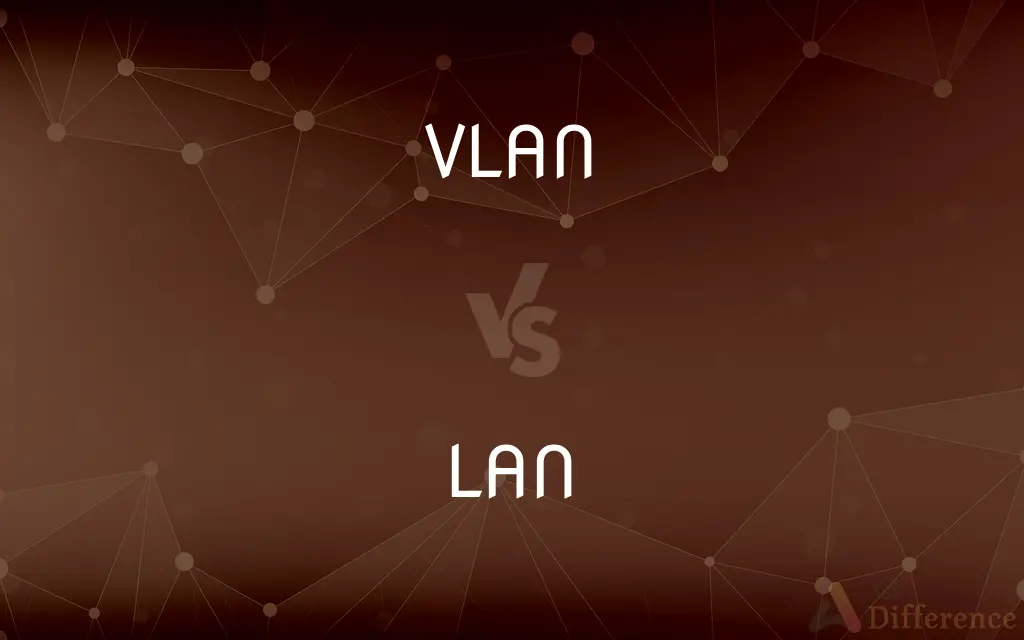VLAN vs. LAN — What's the Difference?
By Tayyaba Rehman — Published on January 13, 2024
VLAN is a logically segmented network within a physical network, enhancing network security and management. LAN is a physical network that connects devices within a limited geographic area, such as an office or home.

Difference Between VLAN and LAN
Table of Contents
ADVERTISEMENT
Key Differences
A Virtual Local Area Network (VLAN) is a technology that allows the segmentation of a single physical network into multiple logical networks. It is achieved by assigning specific network devices to different VLANs, even if they share the same physical infrastructure. VLANs enhance network security and efficiency by isolating traffic, controlling broadcast domains, and simplifying network management. This segmentation is often used in enterprise environments to separate different departments or user groups while utilizing the same physical network infrastructure.
A Local Area Network (LAN) is a physical network that interconnects devices within a limited geographic area, such as an office building, school, or home. LANs are characterized by high data transfer rates, low latency, and the ability to share resources like printers and file servers. They are commonly used to facilitate communication and data exchange among computers and other devices within a localized environment. LANs can be wired, using technologies like Ethernet, or wireless, utilizing Wi-Fi.
The primary difference between VLAN and LAN lies in their scope and purpose. VLAN is a logical segmentation of a larger LAN, allowing the network to be divided into multiple smaller, isolated subnetworks. In contrast, LAN refers to the entire physical network within a specific geographic area. VLANs provide a way to organize and secure traffic within a LAN by creating distinct virtual networks, whereas a LAN encompasses all connected devices in a given location.
VLANs are designed to enhance network efficiency and security. They reduce broadcast traffic by confining broadcasts to devices within the same VLAN, preventing unnecessary network congestion. LANs, on the other hand, serve as the physical infrastructure that supports VLANs and provides the essential connectivity between devices. LANs facilitate the communication of devices within their geographical proximity and are responsible for the physical transport of data packets.
Comparison Chart
Definition
A logical segmentation of a physical LAN into multiple virtual networks.
A physical network connecting devices within a limited geographic area.
ADVERTISEMENT
Scope
Typically used within a larger LAN.
Refers to the entire local network.
Purpose
Enhances network security, isolates traffic, simplifies management.
Facilitates communication among devices within a localized area.
Segmentation
Segments a LAN into multiple isolated virtual networks.
Represents the physical network infrastructure.
Traffic Isolation
Isolates traffic between VLANs, reducing broadcast domains.
Shares data and resources among devices on the same LAN.
Connectivity
Requires a physical LAN for devices to communicate across VLANs.
Provides the physical infrastructure for device connectivity.
Example
Creating separate VLANs for HR and IT departments on a corporate network.
Connecting computers and printers within an office building.
Compare with Definitions
VLAN
VLAN (Virtual Local Area Network) is a technology that logically segments a physical network into isolated virtual networks.
In a corporate network, VLANs are used to separate guest Wi-Fi traffic from internal company data.
LAN
LANs offer high-speed data transfer, low latency, and resource sharing among connected devices.
Our LAN allows employees to share files and print documents on the same network.
VLAN
VLANs enhance network security and efficiency by isolating traffic and simplifying management.
By using VLANs, an organization can isolate sensitive data from public-facing services.
LAN
LAN (Local Area Network) is a physical network connecting devices within a limited geographic area.
A LAN connects all the computers and printers in our office building.
VLAN
VLANs are commonly used in enterprise networks to segment and organize traffic.
VLANs enable network administrators to apply specific policies to different user groups.
LAN
LANs are commonly used in homes, offices, and schools to facilitate local device communication.
Wi-Fi routers create LANs that enable wireless device connectivity at home.
VLAN
VLANs allow devices in different subnetworks to communicate while sharing the same physical network.
A VLAN can enable secure communication between a production server and a development server.
LAN
LANs are essential for local device connectivity and are the foundation for network services.
The LAN provides the backbone for our local network services, such as internet access.
VLAN
VLANs reduce broadcast traffic by confining broadcasts to devices within the same VLAN.
Broadcasts in the HR VLAN don't affect devices in the Sales VLAN.
LAN
LANs can be wired using technologies like Ethernet or wireless using Wi-Fi.
Our LAN includes both wired and wireless connections for flexibility.
LAN
A system that links together electronic office equipment, such as computers and printers, and forms a network within an office, building, or group of buildings
LAN
A local area network; a network{3} connecting computers and word processors and other electronic office equipment within a small area, to create an inter-office system, typically within one building or one site of a corporation. Contrasted to WAN, a wide-area network.
LAN
A local computer network for communication between computers; especially a network connecting computers and word processors and other electronic office equipment to create a communication system between offices
Common Curiosities
What is a LAN?
A LAN, or Local Area Network, is a physical network that connects devices within a confined geographic area, such as an office or home.
What is a VLAN?
A VLAN, or Virtual Local Area Network, is a logical network segment created within a physical network to isolate and organize devices.
How does a VLAN work?
VLANs work by tagging data packets to distinguish different segments, allowing devices in the same VLAN to communicate while keeping traffic separate from other VLANs.
What is the primary purpose of VLANs?
VLANs are primarily used to enhance network security, reduce broadcast traffic, and simplify network management by segmenting a larger LAN into isolated networks.
How does a LAN facilitate resource sharing among devices?
LANs enable devices to share resources like files, printers, and internet access, making them valuable in collaborative environments.
What is the scope of a LAN?
LANs cover a specific physical area, connecting devices within that location, and provide the infrastructure for communication.
Can a VLAN exist without a LAN?
No, VLANs are logical networks that rely on the physical infrastructure of a LAN to transport data between devices.
What types of devices can be connected in a LAN?
LANs accommodate various devices, including computers, printers, servers, and networking equipment.
Are VLANs limited to wired networks?
No, VLANs can be implemented in both wired and wireless LANs, allowing for flexible network design.
How are VLANs implemented in network equipment?
VLANs are configured on managed switches and routers, where specific ports are assigned to VLANs based on criteria like device type or department.
What is the key benefit of using VLANs for network security?
VLANs isolate traffic, preventing unauthorized access between segments and enhancing overall network security.
Can VLANs span multiple physical locations?
VLANs are typically confined to a single physical location or building; however, they can be extended over a Wide Area Network (WAN) using appropriate technology.
Can VLANs be used to optimize network traffic?
Yes, VLANs help optimize network traffic by segmenting data into smaller, manageable segments, reducing congestion and enhancing performance.
Are VLANs and LANs suitable for home networks?
While VLANs are more common in enterprise networks, LANs are widely used in home networks, providing connectivity for devices within the house.
What is the difference between a LAN switch and a VLAN switch?
A LAN switch connects devices within a LAN, while a VLAN switch is configured to support VLANs, allowing the creation of multiple virtual networks on a single physical switch.
Share Your Discovery

Previous Comparison
Visa Signature vs. Visa Platinum
Next Comparison
Cooperator vs. CollaboratorAuthor Spotlight
Written by
Tayyaba RehmanTayyaba Rehman is a distinguished writer, currently serving as a primary contributor to askdifference.com. As a researcher in semantics and etymology, Tayyaba's passion for the complexity of languages and their distinctions has found a perfect home on the platform. Tayyaba delves into the intricacies of language, distinguishing between commonly confused words and phrases, thereby providing clarity for readers worldwide.
















































